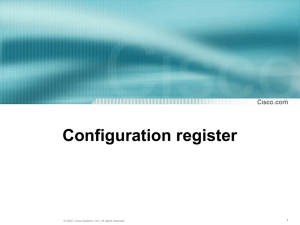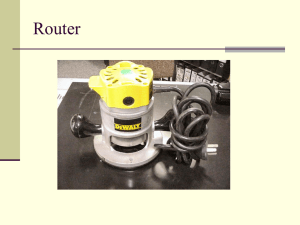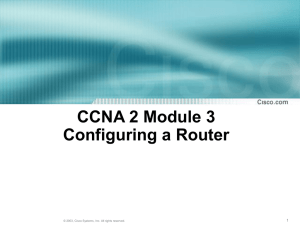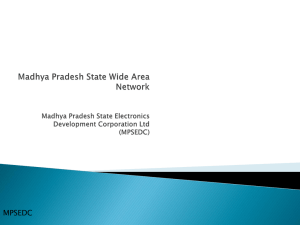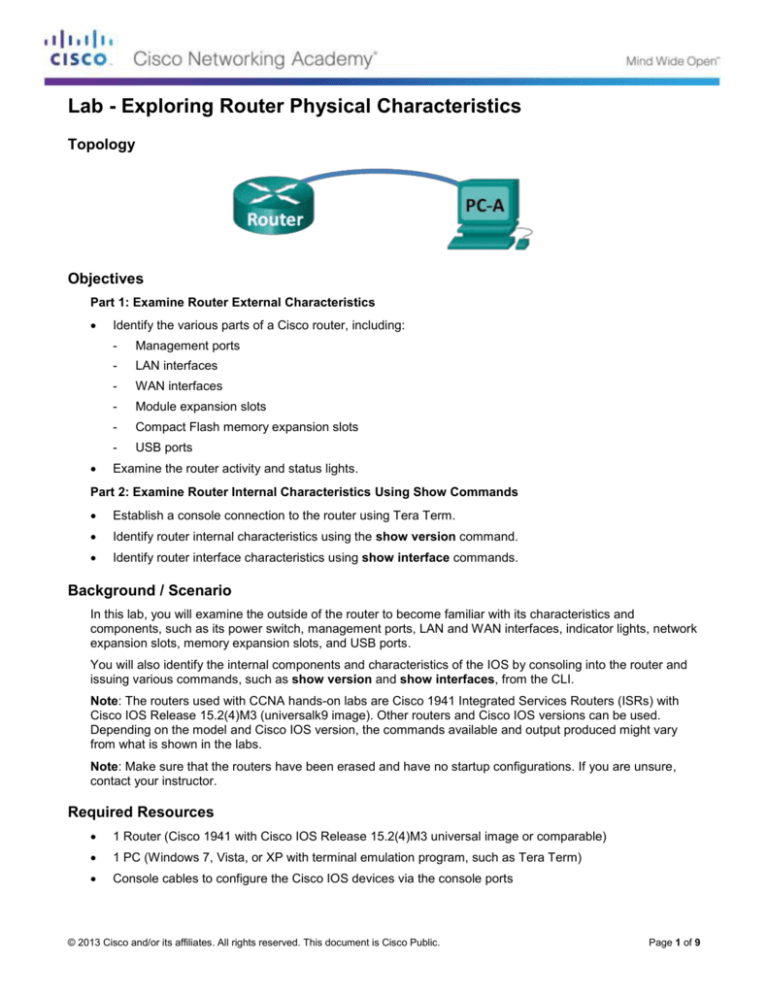
Lab - Exploring Router Physical Characteristics
Topology
Objectives
Part 1: Examine Router External Characteristics
Identify the various parts of a Cisco router, including:
-
Management ports
-
LAN interfaces
-
WAN interfaces
-
Module expansion slots
-
Compact Flash memory expansion slots
-
USB ports
Examine the router activity and status lights.
Part 2: Examine Router Internal Characteristics Using Show Commands
Establish a console connection to the router using Tera Term.
Identify router internal characteristics using the show version command.
Identify router interface characteristics using show interface commands.
Background / Scenario
In this lab, you will examine the outside of the router to become familiar with its characteristics and
components, such as its power switch, management ports, LAN and WAN interfaces, indicator lights, network
expansion slots, memory expansion slots, and USB ports.
You will also identify the internal components and characteristics of the IOS by consoling into the router and
issuing various commands, such as show version and show interfaces, from the CLI.
Note: The routers used with CCNA hands-on labs are Cisco 1941 Integrated Services Routers (ISRs) with
Cisco IOS Release 15.2(4)M3 (universalk9 image). Other routers and Cisco IOS versions can be used.
Depending on the model and Cisco IOS version, the commands available and output produced might vary
from what is shown in the labs.
Note: Make sure that the routers have been erased and have no startup configurations. If you are unsure,
contact your instructor.
Required Resources
1 Router (Cisco 1941 with Cisco IOS Release 15.2(4)M3 universal image or comparable)
1 PC (Windows 7, Vista, or XP with terminal emulation program, such as Tera Term)
Console cables to configure the Cisco IOS devices via the console ports
© 2013 Cisco and/or its affiliates. All rights reserved. This document is Cisco Public.
Page 1 of 9
Lab - Exploring Router Physical Characteristics
Examine Router External Characteristics
Use the images below, as well as your own direct inspection of the backplane of a Cisco router, to answer the
following questions. Feel free to draw arrows and circle the areas of the image that correctly identify the parts.
Note: The router depicted in the images below is a Cisco 1941 router, which may be different from the make
and model of the routers in your particular academy. You can find device information and specifications for
the Cisco 1941 series routers at the Cisco.com website. Additional information, including answers to many of
the questions below can be found here:
http://www.cisco.com/en/US/prod/collateral/routers/ps10538/data_sheet_c78_556319.html
Step 1: Identify the various parts of a Cisco router.
The image shown in this step is of the backplane of a Cisco 1941 ISR. Use it to answer the questions in this
step. In addition, if you are examining a different model router, a space has been provided here for you to
draw the backplane and identify components and interfaces as specified in the questions that follow.
Power Switch
Serial
Aux
GE
U
S
B
Console
Mini usb
© 2013 Cisco and/or its affiliates. All rights reserved. This document is Cisco Public.
Page 2 of 9
Lab - Exploring Router Physical Characteristics
a. Circle and label the router’s power switch. Is the power switch on your router in the same area as the
router depicted in the image?
____Nope it is on the right of the router on the one that I am using
b. Circle and label the management ports. What are the built-in management ports? Are the management
ports the same on your router? If not, how are they different?
Fa0/0 and Fa 0/1, console, and aux is on the one I am using and Ga 0/0 Ga0/1 and 2 usb and 1 Aux and
1 console ones is on the one that’s in the picture.
c.
Circle and label the router’s WAN interfaces. How many WAN interfaces does the router in the image
have and what is the interface technology type? Are the WAN interfaces the same on your router? If not,
how are they different? There is none
____________________________________________________________________________________
d. The Cisco 1941 ISR is a modular platform and comes with module expansion slots for varied network
connectivity requirements. Circle and label the module slots. How many module slots are there? How
many are used? What type of module expansion slots are they? Are the module slots the same on your
router? If not, how are they different?
___there are two on the router in the picture and there is only one on the on the router I am using
e. The Cisco 1941 router comes with CompactFlash memory slots for high speed storage. Circle and label
the CompactFlash memory slots. How many memory slots are there? How many are used? How much
memory can they hold? Are the memory slots the same on your router? If not, how are they different?
There is only one flash memory slot on the one I am using and none on the picture.
____________________________________________________________________________________
f.
The Cisco 1941 router comes with USB 2.0 ports. The built-in USB ports support eToken devices and
USB flash memory. The USB eToken device feature provides device authentication and secure
configuration of Cisco routers. The USB flash feature provides optional secondary storage capability and
an additional boot device. Circle and label the USB ports. How many USB ports are there? Are there USB
ports on your router? There are 2 on the router in the picture and none on my router
____________________________________________________________________________________
g. The Cisco 1941 router also comes with a mini-B USB console port. Circle and label the mini-B USB
console port.
____________________________________________________________________________________
Step 2: Examine the router activity and status lights.
The following images highlight the activity and status lights of the front panel and backplane of a powered up
and connected Cisco 1941 ISR.
Note: Some of the indicator lights are obscured from view in the image of the backplane of the Cisco 1941
router below.
© 2013 Cisco and/or its affiliates. All rights reserved. This document is Cisco Public.
Page 3 of 9
Lab - Exploring Router Physical Characteristics
a. In the top image above, examine the indicator lights on the front panel of the router? The lights are
labeled SYS, ACT, and POE. What do the labels refer to? What do the lights in the image indicate about
the status of the router? These labels would be readable if they were not lit.
SYS means system is on. Act is the router is working
____________________________________________________________________________________
____________________________________________________________________________________
____________________________________________________________________________________
b. In the backplane image above, examine the indicator lights on the router. There are three visible activity
lights, one for each of the connected interfaces and management ports. Examine the interface lights on
your router. How are the lights labeled, and what is their meaning?
FDX, 100, Link, and they mean the router is up and running
© 2013 Cisco and/or its affiliates. All rights reserved. This document is Cisco Public.
Page 4 of 9
Lab - Exploring Router Physical Characteristics
____________________________________________________________________________________
c.
Aside from the management ports and network interfaces, what other indicator lights are on the
backplane of the router and what might their purpose be?
____________________________________________________________________________________
____________________________________________________________________________________
____________________________________________________________________________________
Examine Router Internal Characteristics Using Show Commands
Step 1: Establish a console connection to the router and use the show version command.
a. Using Tera Term, console into the router and enter privileged EXEC mode using the enable command:
Router> enable
Router#
b. Display information about the router by using the show version command. Use the Spacebar on the
keyboard to page through the output.
Router# show version
Cisco IOS Software, C1900 Software (C1900-UNIVERSALK9-M), Version 15.2(4)M3, RELEASE
SOFTWARE (fc1)
Technical Support: http://www.cisco.com/techsupport
Copyright (c) 1986-2011 by Cisco Systems, Inc.
Compiled Thu 26-Jul-12 19:34 by prod_rel_team
ROM: System Bootstrap, Version 15.0(1r)M15, RELEASE SOFTWARE (fc1)
Router uptime is 1 day, 14 hours, 46 minutes
System returned to ROM by power-on
System restarted at 07:26:55 UTC Mon Dec 3 2012
System image file is "flash0:c1900-universalk9-mz.SPA.152-4.M3.bin"
Last reload type: Normal Reload
Last reload reason: power-on
<output omitted>
If you require further assistance please contact us by sending email to
export@cisco.com.
Cisco CISCO1941/K9 (revision 1.0) with 487424K/36864K bytes of memory.
Processor board ID FGL16082318
2 Gigabit Ethernet interfaces
2 Serial(sync/async) interfaces
1 terminal line
1 Virtual Private Network (VPN) Module
DRAM configuration is 64 bits wide with parity disabled.
255K bytes of non-volatile configuration memory.
250880K bytes of ATA System CompactFlash 0 (Read/Write)
<output omitted>
© 2013 Cisco and/or its affiliates. All rights reserved. This document is Cisco Public.
Page 5 of 9
Lab - Exploring Router Physical Characteristics
Technology Package License Information for Module:'c1900'
----------------------------------------------------------------Technology
Technology-package
Technology-package
Current
Type
Next reboot
-----------------------------------------------------------------ipbase
ipbasek9
Permanent
ipbasek9
security
securityk9
Permanent
securityk9
data
None
None
None
Configuration register is 0x2102
c.
Based on the output of the show version command, answer the following questions about the router. If
you are examining a different model router, include the information about it here.
1) What is the version of the Cisco IOS and what is the system image filename?
__c1841-ADVSECURITYK9-M version 15.1
2) What is the Bootstrap program version in ROM BIOS?
Version 15.1
________________________________________________________________________________
3) How long has the router been running without a restart (also known as its uptime)?
23 mins
________________________________________________________________________________
4) How much dynamic random-access memory (DRAM) memory does the router have?
64 bites
________________________________________________________________________________
5) What is the router’s processor board ID number?
FTX1135W0EH
________________________________________________________________________________
6) What network interfaces does the router have?
2 FE, 2 low speed serial, 1 Virtual private network
________________________________________________________________________________
7) How much CompactFlash memory for IOS storage is there?
984816k bytes
________________________________________________________________________________
8) How much nonvolatile random-access memory (NVRAM) memory for configuration file storage is
there?
191Bytes
________________________________________________________________________________
9) What is the setting of the configuration register?
0x2102
© 2013 Cisco and/or its affiliates. All rights reserved. This document is Cisco Public.
Page 6 of 9
Lab - Exploring Router Physical Characteristics
________________________________________________________________________________
Step 2: Use the show interface command to examine the network interfaces.
a. Use the show interface gigabitEthernet 0/0 command to see the status of the Gigabit Ethernet 0/0
interface.
Note: After typing part of the command, for example, show interface g, you can use the Tab key on your
keyboard to complete the gigabitEthernet command parameter.
Router# show interface gigabitEthernet 0/0
GigabitEthernet0/0 is administratively down, line protocol is down
Hardware is CN Gigabit Ethernet, address is 442b.031a.b9a0 (bia 442b.031a.b9a0)
MTU 1500 bytes, BW 100000 Kbit/sec, DLY 100 usec,
reliability 255/255, txload 1/255, rxload 1/255
Encapsulation ARPA, loopback not set
Keepalive set (10 sec)
Full Duplex, 100Mbps, media type is RJ45
output flow-control is unsupported, input flow-control is unsupported
ARP type: ARPA, ARP Timeout 04:00:00
Last input never, output never, output hang never
Last clearing of "show interface" counters never
Input queue: 0/75/0/0 (size/max/drops/flushes); Total output drops: 0
Queueing strategy: fifo
Output queue: 0/40 (size/max)
5 minute input rate 0 bits/sec, 0 packets/sec
5 minute output rate 0 bits/sec, 0 packets/sec
3 packets input, 276 bytes, 0 no buffer
Received 0 broadcasts (0 IP multicasts)
0 runts, 0 giants, 0 throttles
0 input errors, 0 CRC, 0 frame, 0 overrun, 0 ignored
0 watchdog, 0 multicast, 0 pause input
0 packets output, 0 bytes, 0 underruns
0 output errors, 0 collisions, 0 interface resets
0 unknown protocol drops
0 babbles, 0 late collision, 0 deferred
0 lost carrier, 0 no carrier, 0 pause output
0 output buffer failures, 0 output buffers swapped out
b. Given the output of the show interface gigabitEthernet 0/0 command depicted above, or using the
output from your router, answer the following questions:
What is the hardware type and MAC address of the Gigabit Ethernet interface?
442b.031a.b9a0
____________________________________________________________________________________
What is the interface media type? Is the interface up or down?
Up
____________________________________________________________________________________
c.
Use the show interfaces serial 0/0/0 command to view the status of the Serial 0/0/0 interface.
Router# show interface serial 0/0/0
© 2013 Cisco and/or its affiliates. All rights reserved. This document is Cisco Public.
Page 7 of 9
Lab - Exploring Router Physical Characteristics
Serial0/0/0 is administratively down, line protocol is down
Hardware is WIC MBRD Serial
MTU 1500 bytes, BW 1544 Kbit/sec, DLY 20000 usec,
reliability 255/255, txload 1/255, rxload 1/255
Encapsulation HDLC, loopback not set
Keepalive set (10 sec)
Last input 07:41:21, output never, output hang never
Last clearing of "show interface" counters never
Input queue: 0/75/0/0 (size/max/drops/flushes); Total output drops: 0
Queueing strategy: fifo
Output queue: 0/40 (size/max)
5 minute input rate 0 bits/sec, 0 packets/sec
5 minute output rate 0 bits/sec, 0 packets/sec
1 packets input, 24 bytes, 0 no buffer
Received 1 broadcasts (0 IP multicasts)
0 runts, 0 giants, 0 throttles
0 input errors, 0 CRC, 0 frame, 0 overrun, 0 ignored, 0 abort
0 packets output, 0 bytes, 0 underruns
0 output errors, 0 collisions, 2 interface resets
0 unknown protocol drops
0 output buffer failures, 0 output buffers swapped out
1 carrier transitions
DCD=down DSR=down DTR=down RTS=down CTS=down
d. Given the output command depicted above, answer the following questions:
What is the frame encapsulation type?
HDLC
___________________________________________________________________________________
What is the hardware type? Is the interface up or down?
WIC MBRD Serial
______________________________________________________________________________
Reflection
1. Why might you need to use an EHWIC expansion slot?
Because you might need it for different tasks
_______________________________________________________________________________________
2. Why might you need to upgrade the Flash memory?
Because you are running out of space or you just might need bigger storage
_______________________________________________________________________________________
3. What is the purpose of the mini-USB port?
So you can do it threw there like a usb
_______________________________________________________________________________________
_______________________________________________________________________________________
© 2013 Cisco and/or its affiliates. All rights reserved. This document is Cisco Public.
Page 8 of 9
Lab - Exploring Router Physical Characteristics
_______________________________________________________________________________________
4. What is the purpose of the ISM/WLAN indicator light on the backplane of the router? What does it refer to?
It will tell you if it is working or not.
_______________________________________________________________________________________
© 2013 Cisco and/or its affiliates. All rights reserved. This document is Cisco Public.
Page 9 of 9





